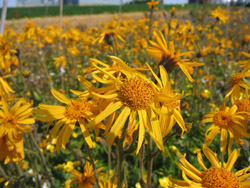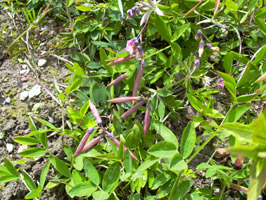Some of the plants grown in this group have a clear commercial outlet
(e.g. Arnica) while others (e.g. Angelica) are more speculative but of
considerable interest because of their history of traditional use.
Angelica
(Angelica archangelica)
This is a herbaceous, aromatic herb native to Eurasia and which is commercially
cultivated in Belgium, Germany and France. Some have attributed its occurrence
in Orkney to a Viking introduction.
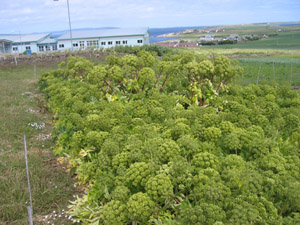 |
Uses: Angelica has a strong tradition of use in herbal medicine. Oil can also be extracted from the root or seed and is used in perfumes, soaps and shampoos. Roots and seeds are widely used in liqueurs (e.g. Benedictine, chartreuse, gin and vermouth). Leaves may be cooked and eaten while the leaf stalks can be candied and used in cakes and desserts.
Arnica. (Arnica
montana and A. chamissonis)
A. montana is a herbaceous perennial occurring in the mountainous parts
of Europe from Norway to Portugal. In many countries, wild populations
of the plant are in serious decline as a result of habitat loss and over-exploitation
for medical purposes. As a result, there have been several recent attempts
to cultivate A. montana and there is also interest in the possibility
of using extracts from A. chamissonis which is a closely related north
American species.
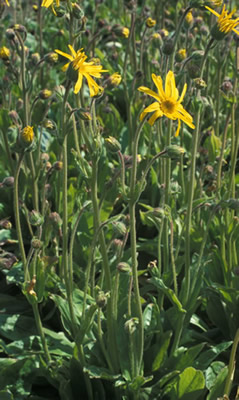 |
*Arnica montana, Orkney College 2006 |
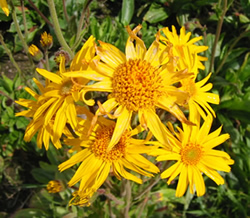 |
Uses. Extracts are obtained from roots and flowers and are used externally in creams and ointments for treatment of sprains and bruises.
Bitter Vetch. (Lathyrus
linifolius)
This is a herbaceous plant of the pea family which produces a small tuber.
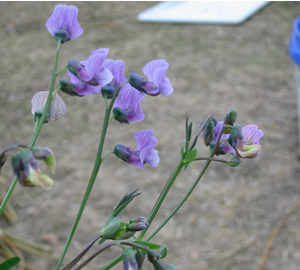 |
* Bitter Vetch, Orkney College 2003 |
Uses: It has a tradition of use in Scotland where the tuber was used to make a liquorice-flavoured drink having stimulant properties and taking away appetite.
Scotch Lovage (Ligusticum scoticum)
This is a long-lived perennial in the same family as Garden Lovage, Levisticum
officinale. It is common on cliffs and rocky shores of Scotland and occurs
in Orkney.
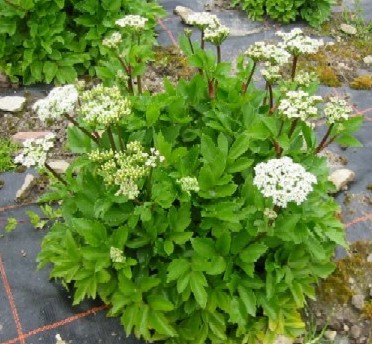 |
* Scotch Lovage, Orkney College 2003
Uses: the leaves are edible and the plant was formerly cultivated in the same way as celery. It was also taken by sailors for scurvy after they returned from long voyages. The young shoots and leaf stalks can be eaten raw or used to flavour stews.
Bog Myrtle (Myrica gale)
This is a perennial shrub which is native to, and common in, the wetter part of the Highlands and Islands. It has a tradition of use as a flavouring, for wound healing and as an insect repellent. Recently, it has attracted attention for its oil which has a range of potential uses. There is no tradition of cultivating the plant, but in 2005, using plants provided by Highland Natural Products Ltd and Alba Trees Plc, the Institute established a small observation plot of the crop in 2005.
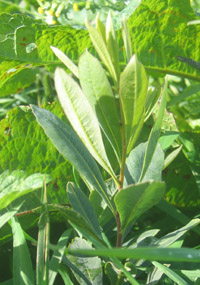 |
Water mint (Mentha aquatica). Like other species of mint, this one contains essential oils of potential use in the pharmaceutical and food industry.
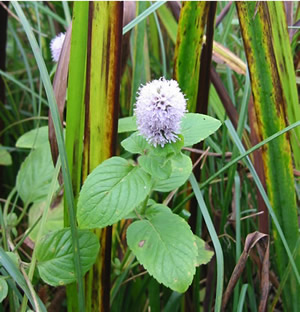 |
